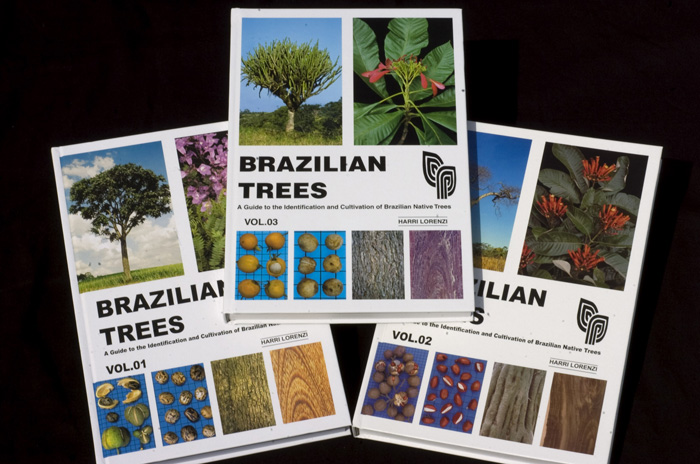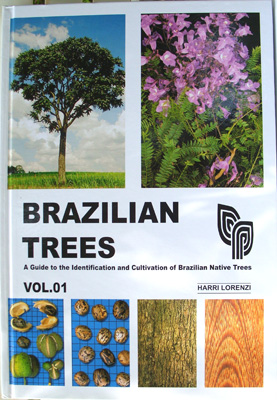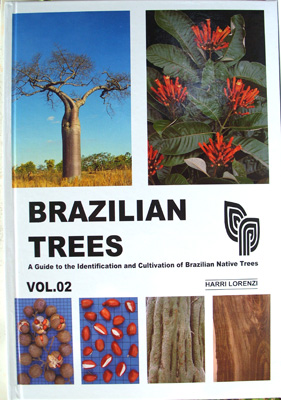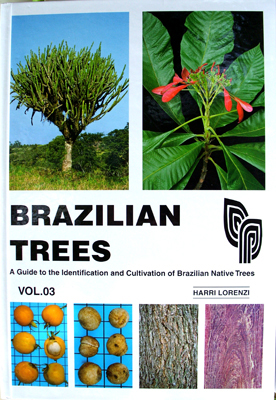Brazilian Trees:
A Guide to the Cultivation
and Identification of Brazilian Trees
Volume 1 to
Volume 3

I
recently acquired not one but three books on native Brazilian trees.
Considering the size of Brazil, and its immense diversity of species,
it comes as no surprise that it takes three volumes to cover most of
the trees. Author Harri Lorenzi has made the production of these books
a labor of love and dedication that spans almost four decades.
Each
volume both comprises a part of a set and stands alone on individual
merits. This is accomplished by mixing of Family, Genus and species
rather than progressing through them in a ridged alphabetical order by
Family or Genus. Some Families have entries in all three
volumes.
Each volume has some things in common with the others and I want to
cover these commonalities first.
These volumes are the result of
many years of cumulative research and the reader sees this in the
writing. The writing is clear, concise and well organized, the
dedication of the author shows through. Since I do not speak Portuguese
I had feared that the English might lack, as it does in so many books
translated from out of the English-speaking world – the English is
excellent. Another important point is that the text for each species is
consistent, providing the same format and information for each.
All
three are illustrated profusely. In truth the books are about
illustrating the trees and anything but full color would have fallen
short of perfection. The images are clear and consistent in design and
quality throughout all three. For each tree there are six images: adult
plant, leaf or flower detail, fruit, seeds, trunk, wood. Knowing
exactly what he wanted author Lorenzi (with few exceptions) took the
images himself.
Extremely useful features are the information
provided on ecological place, blooming season and seed collection and
longevity. Many will also find the information on wood characteristics
of interest. The listings have information on edibility or other uses
as well. Common names are given in more than one language when
available.
As a collector of books I am concerned with the
quality of the books themselves. I am pleased to say that I find the
printing and binding of the highest quality workmanship. (I do miss
dust jackets, but they would hide the images on the binding). The paper
is heavy enough that there is no annoying bleed-through of the printing
on the other side and the inks used are stable and images clear. The
images also do not show fingerprints easily, which preserves the good
appearance of the images with use. The archival, coated paper gives
sharp, crisp images and I saw no tendency for the ink to smear.
The
three volumes total over 1,100 pages and cover 1,056 species (one per
page, 352 in each volume) and contain an amazing 6,336 images (2,112
each volume). All three volumes have valuable indices (common
and
scientific names) and a special seed index that lists species by month.
Together these volumes provide what may be the most comprehensive,
detailed illustrated account of trees in Brazil. Doubtless the most
detailed and comprehensive available in English. Yet so vast is the
Brazilian landscape that not every tree is listed. Size: 8.25 x 12,
hardbound, color photographs. These are also available in
Portuguese.
Author Harri Lorenzi (born 1949) is a
Brazilian agronomist with a background in botany and horticulture. To
date he has accumulated over 35 years of experience and written 20
books on plants. He is founder and director of the 10 ha botanical
garden "Jardim Botânico Plantarum" located in the state of São Paulo -
Brazil (not yet open to public), dedicated solely to the flora of
Brazil, with cerca 5 thousand species, plus an Herbarium with 35
thousand
specimens and one of the most complete plant taxonomic library in the
country. http://www.plantarum.org.br
Volume Notes:
 |
Brazilian Trees: A
Guide to the Cultivation and Identification of Brazilian Trees - Volume
01

ISBN 85-86714-17-8
First
printed in 1992 and updated when reprinted – I have the 4th edition
from 2002. Volume covers the most well known trees in Brazil, a number
of which are rare or unknown in other locations. Cashew Nut
(Anacardiaceae) is the first and canelo (Winteraceae) the last with
relatives of Bougainvillea, Podocarpus and many more between. The 352
species come from 62 families.
Besides the cashew other edible
species present include Annona, Bixa, Eugenia, Syagrus and many others.
Timber, forage and ornamentals are also included. |
 |
Brazilian Trees: A
Guide to the Cultivation and Identification of Brazilian Trees - Volume
02

ISBN 85-86714-15-1
My
2002 edition is updated from the first edition in 1998.Volume two
centers on trees much less common than those in volume one. Many of
limited distribution and some threatened by exploitation. The 352
species covered are from 66 families with some edible and others being
ornamental or useful in other ways. |
 |
Brazilian Trees: A
Guide to the Cultivation and Identification of Brazilian Trees - Volume
03

ISBN 85-86714-34-4
This
newest of the three, first edition, printed in 2009, will be updated in
subsequent printings should the need arise. Volume three covers species
from 76 families and contains trees even less common then those in the
first two volumes. Less common trees, but not less important - and with
a higher percentage of trees facing extinction. Trees in this
volume
may be rare due to having limited natural distribution or due to loss
of forest to farm or other development. Many are endemic to small areas
in Brazil. Some rare species are protected from extinction only by
their
remote habitat. There are also more trees of culinary use than in the
first two volumes. |
Overall Recommendation
5/5 
My
recommendation is that these volumes belong is any serious botanical or
horticultural collection as well as collections on South America and
Brazil. At about $60USD each they are not inexpensive ~ but the
information
they contain far exceeds the cost of the books. The quality of the
binding, and archival paper, should provide years if not generations of
service.
Order from the author at his web page through a virtual store in both
Portuguese and English:
www.plantarum.com.br/
or from your bookseller. Use the ISBN numbers on this page for English
text. (Use o número do ISBN desta página para o texto em inglês.)
Please mention this review when ordering.
Page Contents Copyright © 2010 All Rights Reserved
Top Image Harri Lorenzi, other images Bob G. Cannon
II
In the event of any conflict the English version of this review is to
be used as official.
Disclaimer
(made necessary by abuses on the Internet by some promoting products):
Like all book reviewers from time immortal (well since there have been
books to review) the books reviewed may have been free, sample or
complementary copies. The same is true of most product reviews. This
practice is long established and the material may be sent out to
various reviewers in the hopes of producing a good review. We promise
no one who sends us books or products a good review, nor are we paid to
write one. We do promise that any review will be an honest evaluation –
be it good or bad. Items we are particularly happy with may be offered
for sale through one of our sites where a commission may be made on
sales.
™




